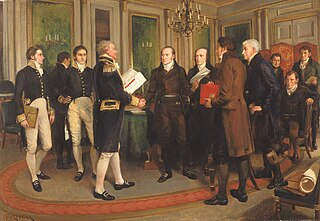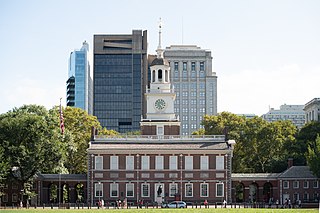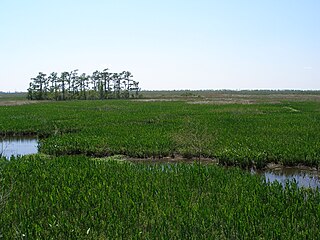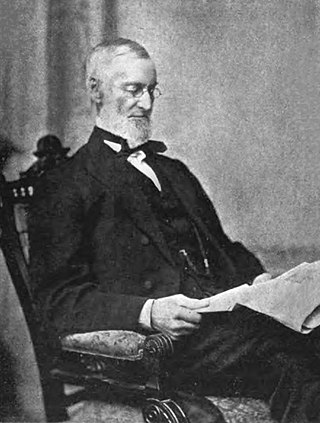
William Henry Harrison was an American military officer and politician who served as the ninth president of the United States. Harrison died just 31 days after his inauguration as president in 1841, making his presidency the shortest in U.S. history. He was also the first U.S. president to die in office, causing a brief constitutional crisis since presidential succession was not then fully defined in the United States Constitution. Harrison was the last president born as a British subject in the Thirteen Colonies and was the paternal grandfather of Benjamin Harrison, the 23rd president of the United States.

The War of 1812, called the American War of 1812 in Britain, was fought by the United States and its indigenous allies against the United Kingdom and its own indigenous allies in British North America, with limited participation by Spain in Florida. It began when the United States declared war on Britain on 18 June 1812. Although peace terms were agreed upon in the December 1814 Treaty of Ghent, the war did not officially end until the peace treaty was ratified by the United States Congress on 17 February 1815.

Put-in-Bay is a resort village located on South Bass Island in Put-in-Bay Township, Ottawa County, Ohio, United States, 85 miles (137 km) west of Cleveland and 35 miles (56 km) east of Toledo. The population was 154 at the 2020 census.

The Battle of New Orleans was fought on January 8, 1815, between the British Army under Major General Sir Edward Pakenham and the United States Army under Brevet Major General Andrew Jackson, roughly 5 miles (8 km) southeast of the French Quarter of New Orleans, in the current suburb of Chalmette, Louisiana.

The Treaty of Ghent was the peace treaty that ended the War of 1812 between the United States and the United Kingdom. It took effect in February 1815. Both sides signed it on December 24, 1814, in the city of Ghent, United Netherlands. The treaty restored relations between the two parties to status quo ante bellum by restoring the pre-war borders of June 1812. Both sides were eager to end the war. It ended when the treaty arrived in Washington and was immediately ratified unanimously by the United States Senate and exchanged with British officials the next day.

Victory in Europe Day is the day celebrating the formal acceptance by the Allies of World War II of Germany's unconditional surrender of its armed forces on Tuesday, 8 May 1945; it marked the official end of World War II in Europe in the Eastern Front, with the last known shots fired on 11 May. Russia and some former Soviet countries celebrate on 9 May, as Germany's unconditional surrender entered into force at 23:01 on 8 May Central European Time; this corresponded with 01:01 on 9 May in Moscow Time.

National holidays in the United States are 11 calendar dates designated by the U.S. federal government as official holidays. On these days non-essential national offices are closed although the employees receive pay.

Lewis Cass was an American military officer, politician, and statesman. He represented Michigan in the United States Senate and served in the Cabinets of two U.S. Presidents, Andrew Jackson and James Buchanan. He was also the 1848 Democratic presidential nominee. A slave owner himself, he was a leading spokesman for the doctrine of popular sovereignty, which held that the people in each territory should decide whether to permit slavery.

Independence Hall is a historic civic building in Philadelphia, where both the United States Declaration of Independence and the United States Constitution were debated and adopted by America's Founding Fathers. The structure forms the centerpiece of the Independence National Historical Park. Independence Hall was named to the National Register of Historic Places in 1966 and as a World Heritage Site in 1979.

John B. Weller was the fifth governor of California from January 8, 1858, to January 9, 1860, who earlier had served as a congressman from Ohio and a U.S. senator from California, and minister to Mexico.

John Adair was an American pioneer, slave trader, soldier, and politician. He was the eighth Governor of Kentucky and represented the state in both the U.S. House and Senate. A native of South Carolina, Adair enlisted in the state militia and served in the Revolutionary War, during which he was twice captured and held as a prisoner of war by the British. Following the War, he was elected as a delegate to South Carolina's convention to ratify the United States Constitution.

Jean Lafitte National Historical Park and Preserve protects the natural and cultural resources of Louisiana's Mississippi River Delta region. It is named after French pirate Jean Lafitte and consists of six separate sites and a park headquarters.

Constitution Day is an American federal observance that recognizes the adoption of the United States Constitution and those who have become U.S. citizens. It is normally observed on September 17, the day in 1787 that delegates to the Constitutional Convention signed the document in Philadelphia.

Chalmette National Cemetery is a United States National Cemetery located within Jean Lafitte National Historical Park and Preserve in Chalmette, Louisiana. The cemetery is a 17.5-acre (7.1 ha) graveyard adjacent to the site that was once the battleground of the Battle of New Orleans, which took place at the end of the War of 1812. Despite its proximity to the site of the Battle of New Orleans in the War of 1812, the majority of the interments are of soldiers who were casualties or veterans of the American Civil War, the Spanish-American War, World War I, World War II, the Korean War, or the Vietnam War. The cemetery was subsequently closed to new interments.
The results of the War of 1812, which was fought between the United Kingdom and the United States from 1812 to 1814, included no immediate boundary changes. The main result of the War of 1812 has been over two centuries of peace between the two countries.

The Mount Vernon Arsenal is a former United States Army munitions depot (arsenal), was used as a prison for captured Native Americans, and was served as a psychiatric hospital. It is listed on the National Register of Historic Places in Mount Vernon, Alabama. The site is home to the now closed Searcy Hospital. It was listed on the National Register of Historic Places on May 26, 1988, as the Mount Vernon Arsenal-Searcy Hospital Complex.

Henry Roelif Brinkerhoff was an American veteran of the War of 1812 who served as a U.S. Representative from Ohio, serving part of one term in office before his death in 1844.

The Hull's Trace North Huron River Corduroy Segment is a portion of Hull's Trace, a military road running from Urbana, Ohio, to Detroit. Hull's Trace was one of the first federal and military roads in the United States. This segment, the only known extant portion of the Trace, contains the remains of a corduroy road, and is located at approximately 36000 W Jefferson Avenue in Brownstown Charter Township, Michigan. The North Huron River Corduroy Segment of Hull's Trace was listed on the National Register of Historic Places in 2010. As of 2014 it has been preserved and made accessible to the public as the Hulls Trace Unit of the River Raisin National Battlefield Park.

Presidents' Day, officially Washington's Birthday at the federal governmental level, is a holiday in the United States celebrated on the third Monday of February. It is often celebrated to honor all those who served as presidents of the United States and, since 1879, has been the federal holiday honoring Founding Father George Washington, who led the Continental Army to victory in the American Revolutionary War, presided at the Constitutional Convention of 1787, and was the first U.S. president.

Jordan Bankston Noble also known as Jordan B. Noble was an African American soldier and public figure who is best known for his role as a military drummer in the Battle of New Orleans during the War of 1812. Noble's drum played a crucial role in relaying his commander's orders during the surprise assault against the British forces on December 23, 1814, and the main British advance on January 8, 1815. Jordan Noble also served in the Seminole Wars, Mexican-American War under Zachary Taylor, and the American Civil War for the Union.



















